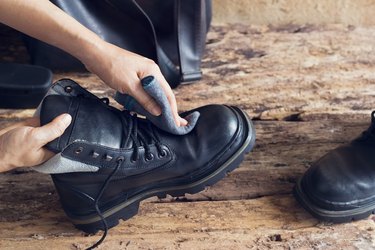Introduction
Leather boots, with their timeless elegance and durability, hold a special place in our footwear collection. However, even the most robust boots can encounter wear and tear over time, tarnishing their pristine appearance and compromising their functionality. Whether it’s faded leather, unsightly scratches, or stubborn stains, restoring your leather boots to their former glory is a rewarding endeavor that can extend their lifespan significantly. In this comprehensive guide, we’ll delve into the art of leather boot repair, empowering you with the knowledge and techniques to breathe new life into your cherished footwear.

Image: theshoebuddy.com
Understanding Leather Types and Their Maintenance Needs
The first step in leather boot repair is understanding the type of leather used in your boots. Common varieties include:
- Full-grain leather: The highest-quality leather, retaining all of its natural characteristics, including grains, pores, and scars.
- Top-grain leather: Similar to full-grain leather, but with a thin layer of finish applied to enhance appearance and durability.
- Genuine leather: The lowest-quality leather, made from the lower layers of the hide and often treated with chemicals to resemble higher-grade leathers.
Different leather types require different cleaning and maintenance methods. Generally, full-grain and top-grain leathers benefit from regular conditioning to preserve their natural oils and prevent cracking. Conversely, genuine leather may require more frequent cleaning and an occasional application of leather polish.
Cleaning Leather Boots: Removing Dirt and Grime
Before attempting any repairs, it’s crucial to thoroughly clean your leather boots. This removes dirt, grime, and old polish, providing a clean base for repairs. Use a soft-bristled brush or a damp cloth to gently remove any loose dirt or debris. Avoid using harsh detergents or waterlogged cloths, as they can damage the leather.
Conditioning Leather Boots: Preserving and Protecting
Regular conditioning nourishes leather, preserving its moisture and flexibility. Apply a wax-based or oil-based conditioner evenly to the entire boot, using a soft cloth or applicator. Allow the conditioner to penetrate for several hours before wiping off any excess. Conditioner not only enhances the appearance of your boots but also protects them from the elements, preventing cracking and fading.

Image: www.hunker.com
Fixing Scratches on Leather Boots: Restoring the Surface
Superficial scratches on leather boots can be concealed or even removed using simple techniques:
- Fine-grit sandpaper: Gently rub fine-grit sandpaper (600 grit or higher) along the scratch in the same direction as the leather grain. Be careful not to apply too much pressure.
- Leather filler: Apply a small amount of leather filler to the scratch using a cotton swab or toothpick. Allow it to dry completely and sand it down to match the surrounding leather.
Removing Stains from Leather Boots: Restoring Color and Vibrancy
Unsightly stains can mar the appearance of your leather boots. Here’s how to tackle different types of stains effectively:
- Grease or oil: Apply cornstarch or baking soda to the stain and allow it to absorb the oil. Brush off the powder and clean the area with a damp cloth.
- Salt stains: Dissolve salt stains by wiping them down with a cloth dipped in a mixture of equal parts water and white vinegar. Rinse with a clean, damp cloth.
- Ink: Apply rubbing alcohol to the stain using a cotton swab. Test it on an inconspicuous part of the boot first to ensure it doesn’t damage the leather.
Reviving Faded Leather Boots: Restoring the Color
Over time, leather boots can lose their vibrant color due to sun exposure, wear and tear, or inappropriate cleaning methods. Here’s how to revive faded leather:
- Leather cleaner: Use a leather cleaner specifically designed for your type of leather to remove any dirt or grime that may impede the color restoration process.
- Leather dye: Choose a leather dye that closely matches the original color of your boots. Apply a thin, even coat of dye using a soft cloth or sponge. Allow it to dry completely and apply additional coats if necessary.
- Leather sealant: Protect your newly colored boots by applying a leather sealant. This will prevent the color from fading prematurely.
Replacing Laces and Hardware: Enhancing Functionality and Style
Worn-out laces or damaged hardware can compromise both the functionality and appearance of your leather boots. Replace them with suitable alternatives:
- Laces: Choose laces that match the style of your boots and provide adequate durability. Consider waxed laces for additional grip and longevity.
- Hardware: Eyelets, buckles, and zippers are essential hardware components that may need occasional replacement. Look for replacements that match the original hardware style and color.
Expert Insights: Tips from the Pros
- “Always clean your leather boots before applying any products, as dirt and grime can interfere with the absorption and effectiveness of conditioners or dyes.” — Ben, Leather Care Specialist
- “Use a soft cloth or brush for cleaning and applying products to avoid damaging the leather’s surface.” — Emily, Footwear Designer
- “Test any new products on an inconspicuous area first, such as the tongue or the inside of the boot.” — Mark, Bootmaker
How To Fix Leather Boots
Conclusion
Restoring your leather boots to their former glory is a rewarding endeavor that can extend their lifespan and enhance their appearance. This comprehensive guide provides you with the knowledge and techniques to tackle a range of repairs, from cleaning and conditioning to removing stains and restoring color. By following these steps and incorporating expert insights into your boot care routine, you can ensure that your leather boots remain a cherished and functional part of your wardrobe for years to come. Remember to consult with a professional shoe repair expert for more complex repairs or if you’re unsure about the appropriate methods for your specific leather type.